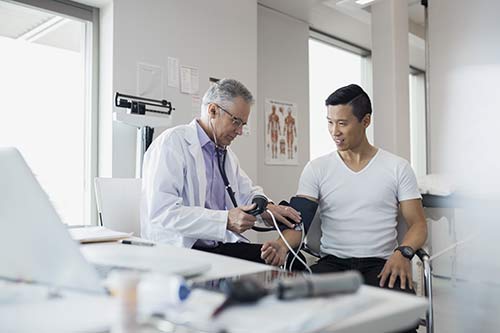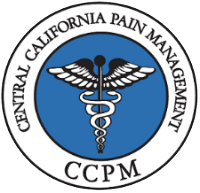Blog

According to the American Academy of Pain Medicine, an estimated 100 million Americans suffer from chronic pain. This makes it one of the most common chronic health problems in the United States. Just under one-third of all chronic pain sufferers experience chronic back pain.
If you have been relieving your back pain at home by taking over-the-counter medications and experiencing little relief, then read on to learn about how you can relieve your back pain at home without taking pills and how a pain management doctor can help relieve your stubborn back pain with simple pain-relieving injections.
Pain Relief Options at Home
To help relieve mild to moderate back pain at home, try these tips.
Walk the Pain Away
If you are like many people, the last thing you may want to do when your back is aching is engaged in exercise of any type. However, a simple walk outdoors or on a treadmill has been shown in studies to help alleviate back pain. In fact, you may find immediate back pain relief after going for just a 20 to 40 minute walk.
One medical study showed that just going for one walk could reduce lower back pain by 10 to 50 percent
immediately. This immediate pain relief is believed to be due to how your body releases more serotonin and endorphins, which are two pain-relieving neurotransmitters, when you perform exercise (even light exercise).
If you walk several times each week, you may experience cumulative pain-relief effects due to how walking strengthens your core and back muscles; strengthening these muscles can help support good spinal alignment to ease some types of back pain.
Try a Lidocaine Cream or Patch
Lidocaine is a numbing agent that has been used in the field of medicine for many years. For example, if your dentist has ever administered a local anesthetic, they likely injected lidocaine in your mouth.
However, topical lidocaine preparations are also available over-the-counter in cream and patch form for back pain relief. Studies have shown that people experiencing lower back pain experienced great pain relief when wearing a lidocaine patch.
Pain Relief Options From a Doctor
If your back pain is more severe or OTC remedies simply do not work for you, then a pain management doctor can offer many pill-free back pain solutions, including the following.
Trigger Point Injections
If your back pain is caused by overly tense or tight muscles, simple trigger point injections may provide you great pain relief. These injections are relatively quick and easy, and during the treatment, your doctor simply injects a numbing agent, such as lidocaine, procaine, or bupivicane, into the tense muscles to provide pain relief. For more severe pain, corticosteroids are often added to the injection solution.
While many people experience long-lasting pain relief after just one trigger point injection, others obtain injections about once a month to help keep pain under control.
Epidural Injections
If your back pain is not caused by tense muscles, but instead sciatica, degenerative disc disease, a compression fracture, or lumbar spinal stenosis, epidural injections may be a better option for you than trigger point injections.
When you receive an epidural injection, a solution of cortisone and a local anesthetic is injected into the area around your spinal cord, called the epidural space. The cortisone has a potent anti-inflammatory effect that can dramatically reduce or even eliminate your back pain.
Cortisone typically takes a few days to begin eliminating back pain, although the injection can cause pain relief that lasts up to several months.
If you experience chronic back pain and are tired of taking OTC pain medications that barely put a dent in your pain or have side affects you cannot tolerate, consider the many pill-free ways to relieve your back pain at home. However, if home remedies are no longer working, then reach out to Central California Pain Management
to discuss all of your back pain relief options.

Suffering from constant neck pain is not a fun thing to live with, but it is difficult to find effective ways to reduce and relieve this type of pain, especially if the pain is a result of an injury. Here are some natural methods you could try that may bring some relief to your neck pain. If they do not offer enough relief, you should visit a pain management clinic.
Get A Different Pillow
The pillow you use could add or relieve the pain you experience in your neck, and one good place to start is purchasing a new pillow. The pillow you use should support your neck's natural posture, and it should provide enough support for your neck. A lot of people choose memory foam pillows for this purpose, but you could try several different types.
When using a pillow at night, make sure you place it in a way that provides support all the way from your head to your shoulders. In other words, do not allow a gap to form below your neck while you sleep. Your neck needs support, and sleeping with the right type of pillow could greatly improve the way your neck feels.
Develop Better Posture Habits
A lot of neck pain comes from the habits a person has. This can include bad posture from the way you sit, walk or sleep. You may need help determining what types of bad posture habits you currently have, and you can talk to a doctor or pain clinic about this.
If you can make the right changes and develop posture habits that support your neck's natural posture, you could see an improvement in the way you feel in just a few weeks.
When you develop better habits, you place less strain on muscles in your back and neck. Your muscles begin working properly and begin to loosen, also reducing the inflammation in these areas.
Go To A Physical Therapist
Physical therapy is often very helpful for relieving neck pain naturally. Through physical therapy, you can learn neck exercises and activities that strengthen the muscles in your neck. If your pain comes from bad posture, you can also learn better habits.
By performing the right exercises, you will gradually see a decrease in the pain you feel in your neck, but you will need to complete these exercises faithfully. You will need to attend physical therapy multiple times to learn them, and you will then need to do them daily or multiple times a day.
Get Deep Massages
Getting deep massages is another natural way to treat neck pain, and this is actually a very enjoyable solution for neck pain. A deep massage works the tightness out of your muscles, and tight muscles are a common cause of neck pain.
During a massage, the therapist will target any trigger spots you have in your neck and upper back. He or she will rub these and apply pressure to them. As they apply pressure, it will loosen these muscles and help release any trapped toxins in them. You may find a lot of relief from the pain during a massage, but massages also offer long-term pain relief if you get them often enough.
Trying natural remedies to relieve neck pain can help some people find the relief they need. If this is not enough relief for the pain you suffer with, contact Central California Pain Management. We offer a lot of different types of treatments for neck and back pain, and we can find a pain-relief treatment option that works effectively for you and the pain you feel.

Fibromyalgia is a mysterious condition that continues to puzzle doctors. In fact, researchers don't necessarily know what causes this condition. Fibro, as it is commonly known, is a disorder that leads to aches and pains that tend to affect the whole body. Here are some symptoms to watch out for.
Chronic Muscle Pain
People with fibromyalgia often feel tightness and pain in their muscles. They may also experience intense spasms. Muscle pain and spasms are very pronounced after exercise. For the pain to be considered chronic, it must be ongoing for at least three months.
The pain does not stop with muscles either. Sometimes people with the condition will feel very stiff when they stand after long periods of time.
Fatigue
For those with fibromyalgia, fatigue may range from moderate to severe. Unfortunately, this is often paired with insomnia and frequently waking up in the middle of the night. When patients are able to get sleep, they often sleep for long periods of time.
It is also frequently reported that those with fibro may also have sleeping disorders like restless leg syndrome and sleep apnea. This makes it even more difficult to get a full night's rest.
Confusion And Difficulty Focusing
It is often hard for people with fibromyalgia to remember details or even to focus on mental tasks. Some people express that this causes them to feel frustrated because they are unable to perform some of the tasks they once did without effort. This is often known as fibro fog.
Abdominal And Digestive Issues
Fibromyalgia is associated with digestive concerns including nausea, bloating and constipation. Patients also report diarrhea and frequent abdominal pain. The symptoms vary from person to person, and some people claim that their digestive issues come and go with the other symptoms.
Headaches
Migraine headaches are common among those suffering from fibromyalgia. This is often linked to sensitivity to noise, lights and smells. Migraines often include throbbing and pulsing pain, often on one side of the head or the other. The pain of a migraine headache can last for hours on end, and the pain can be debilitating.
Some fibromyalgia patients complain of tension headaches too. Tension headaches involve tightening or pressure in the front or back of the head. Most people have had tension headaches at some point, but patients with fibro report symptoms more often.
Anxiety And Depression
Those with fibromyalgia often report that they feel depressed. Often, part of the feelings of depression stems from the isolation that the condition may bring on. People may be in so much pain that they find it difficult to go out and do the things that they once loved to do.
Anxiety is also common among those who experience the pain of fibromyalgia. This makes sense, considering that patients often report feeling anxious that they are going to experience intense pain in the near future. When trying to plan a day out or a special event, the threat of fibro can lead to intense panic.
When To See The Doctor
Symptoms for patients with fibromyalgia fluctuate throughout the day. Some patients report that the evenings tend to have the worst symptoms, whereas others feel the pain worse in the morning. Sometimes symptoms disappear altogether for short periods of time.
Millions of Americans feel the effects of fibromyalgia each day, but only a few actually receive the help that they need for their symptoms. This is because so little is known about the painful condition. If you think that you have fibromyalgia, it is important to see your doctor right away.
Central California Pain Management
may be able to help you find relief from the chronic pain.

If you suffer from fibromyalgia, you will most likely have days when your symptoms seem unbearable and hard to manage. Fortunately, there are some ways you can cope with your symptoms, such as those discussed below.
Rest When You Need It
Your condition already makes you feel worn out. However, you may feel unusually tired at times, especially on or after a day of overexerting yourself.
If you are overtired and keep pushing yourself to continue, you will only exacerbate your symptoms. Eventually, your tired muscles will start to hurt worse, risking an episode of fibromyalgia flare.
When you feel as though your limbs are too heavy to lift and you cannot keep your eyes open, give yourself permission to rest. Take a short nap, if necessary, to recharge your batteries.
Participate in Stress-Reducing Activities
Pushing yourself to the point of exhaustion is not the only way you can increase your symptoms. Stress is also a key contributor to muscle pain and tiredness. When you allow yourself to worry without dealing with your emotions, you will make your symptoms flare up.
When you become overwhelmed with worry, talk to a friend or family member about how you are feeling. If necessary, enlist their help with whatever is troubling you. Or, if you are overburdened, ask them to take part of the load to give you time to destress and relax.
To teach yourself how to deal with stressful situations before they happen, participate in stress-reducing activities. Meditation is one way to calm the mind and relax the muscles. Developing a yoga practice can also help your emotional state, as well as assist you in ways discussed in the next section.
Perform Light Stretching Exercises Every Day
When your fibro pain flares up, the last thing you probably want to do is get up and move around. However, laying around can worsen the tightness and tension in your muscles, adding to the pain you are feeling.
If you do nothing else, at least perform light stretching exercises every day. Stretch your arms and legs out as far as possible, or bend over to touch your toes.
Light yoga exercises can also help you manage your symptoms. These exercises elongate your muscle fibers and increase circulation to your organs and limbs. Yoga can also bring your body back into alignment, which can alleviate the stress on your joints.
Prepare Yourself For Days Of Fibro Fog
On days when you are suffering from fibro fog, you will be unable to focus and concentrate fully on your work. If you try to work too hard, you may add to your stress, which in turn makes the fog and your pain increase.
If you had a bad night of pain or your fibromyalgia causes restless leg syndrome during the night, the lack of sleep can bring about your fibro fog. If you wake up and know you are going to have a day when you cannot think straight, rearrange your work schedule.
If you have work that you cannot ignore, ask for help from a coworker. Or, move other, less-pressing work to another day, and give yourself ample time to complete the important tasks. If you cut your to-do list down, you can better focus and reduce your feelings of being overwhelmed.
Even with your best efforts, you cannot always manage and relieve your fibromyalgia symptoms alone. Contact the office of Dr. Parmar Ashok in central California to make an appointment. After meeting with you during your appointment, he can then discuss a treatment plan
to help you cope with your symptoms and relieve your pain.

If you experience both migraine headaches and neck pain, then you may think that the two symptoms are completely unrelated. However, you may be surprised to hear that multiple surveys have revealed that approximately 75 percent of migraine sufferers experience neck pain during their migraine attacks and the two symptoms are often related.
While neck pain and migraines can occur together for other reasons, when these two symptoms are experienced together, it can often be a sign that you are experiencing cervicogenic headaches. Cervicogenic headaches occur due to neck problems and treating the neck problem that triggers the headaches can help minimize headache occurrence.
Read on to learn more about why cervicogenic headaches occur, the symptoms of these headaches, and their treatment options.
Why Cervicogenic Headaches Occur
Cervicogenic headaches have numerous causes, but all are caused by problems with the neck.
These headaches can occur when the cervical vertebrae are out of alignment. There are arteries in your neck called vertebral arteries, and these arteries are responsible for delivering blood to your brain. When your cervical vertebrae are misaligned, it can interfere with the vertebral arteries' ability to deliver proper blood supply to your brain, depriving your brain of the oxygen that this blood delivers to it.
Misalignment of these vertebrae can also cause compression of nerves in your neck, leading to both neck and head pain.
Cervicogenic headaches can also occur due to other problems with the cervical vertebrae, such as osteoarthritis, a damaged cervical disc, or simple tightness in the neck and shoulder muscles. These conditions can all lead to stimulation of the nerves in your neck that travel to your head.
In addition, trauma to the neck, such as whiplash, can also cause cervicogenic headaches.
Signs of a Cervicogenic Headache
The signs that you are experiencing cervicogenic headaches and not traditional migraines can vary, but just a few include:
- Neck pain accompanies head pain.
- Pain is triggered by sudden neck movements.
- A frequent stiff neck.
- Pain that does not throb and stays isolated to one area of your head.
During your headache spells, you may also experience traditional migraine symptoms, such as nausea, aura, blurred vision, and/or sensitivity to light.
Cervicogenic Headache Treatment Options
If you suspect that you may be experiencing cervicogenic headaches, then it is important to obtain a proper diagnosis. If you have been treating cervicogenic headaches with traditional migraine medications, then having the cause of the headaches treated may be able to control your headaches much more effectively.
An X-ray, MRI, or CT scan can often detect any cervical vertebrae abnormalities that may be causing your cervicogenic headaches. Treatment of your headaches can vary depending on the cause of them.
Occipital Nerve Blocks
Occipital nerve blocks help treat cervicogenic headaches very effectively. The occipital nerves are located in the back of the head, behind the ears. To administer an occipital nerve block
, a pain management specialist will inject a local anesthetic and an anti-inflammatory steroid into the area where the nerve is located.
The anesthetic temporarily numbs the nerve to reduce pain, while the long-acting steroid will relieve nerve inflammation for a much longer period of time to help keep pain from coming back.
Spinal Manipulation
Spinal manipulation can help treat some cervicogenic headaches, including those stemming from misalignment of the cervical vertebrae. This treatment can help realign the cervical vertebrae to reduce compression on the nerves causing head and neck pain.
Transcutaneous Electrical Nerve Stimulation
Transcutaneous electrical nerve stimulation (TENS) is another treatment option that can help cervicogenic headaches stemming from many neck conditions. During this non-invasive treatment, your doctor will connect a device to the nerves in your neck and/or head. The device then sends mild electrical impulses into the nerves triggering your pain. This prevents the nerves from sending pain signals to your brain.
If you experience frequent migraines accompanied by neck pain, then realize that you may be suffering from cervicogenic headaches. Contact Central California Pain Management to have your pain condition diagnosed and discuss your treatment options.
Westside: (661) 587-2468
Eastside: (661) 558-1620
Westside Pain Clinic
Address: 8303 Brimhall Rd #1500, Bakersfield, CA 93312
Eastside Pain Clinic
Address: 3550 Q St. Ste 201 Bakersfield,
CA 93301





